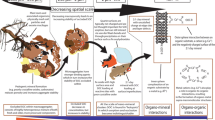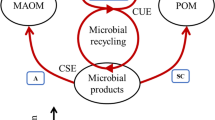Abstract
Chemical weathering rates and erosionrates of granitic till in northern Sweden have beenestimated. The present-day chemical weathering rate iscompared with the long-term average weathering ratesince the last deglaciation approximately 8,700 yearsago. Also, the present-day release rates of major andtrace elements due to chemical weathering are comparedwith the mobility of these elements in a spodosolprofile as shown by soil water samples from the vadozezone. The estimation of the past weathering rate isbased on elemental depletion trends in a soil profile(typic haplocryod), whereas the present weatheringrate is based on elemental input/output budgets in asmall catchment (9.4 km2). The long-term averagechemical erosion rate, expressed as the sum of majorelement oxides (SiO2, Al2O3, CaO,Fe2O3, K2O, MgO, MnO, Na2O,P2O5, TiO2), was estimated to be4.9 gm-2 yr-1. The long-term base cation(Ca2+, Mg2+, Na+, K+) depletionwas 0.325 keq ha-1 yr-1. The currentchemical erosion rate was estimated to be2.4‐3.0 g -2 yr-1, which is at least an order ofmagnitude higher than the rate of physical erosion,and the base cation flux due to chemical weathering is0.356–0.553~keq ha-1 yr-1. However,0.074 keq ha-1 yr-1 of this flux may be related tocation exchange processes induced by atmospheric inputof acid rain. There is no evidence for any recentlyincreased weathering rate of silicates in this area.The inputs of Cd, Cu, Ni and Zn exceed the outputs,and hence, these elements are currently accumulatingin the soil.
There is a distinct seasonal variation in thechemical composition of the soil water. Results fromthe soil water samples show that Na, followed by Siand S (Cl was not measured), are the most mobileelements in the spodosol profile between the E-horizonand the C-horizon, and that Al and Fe were the leastmobile elements. However, there is no simplerelationship between the mobility of an element in thespodosol profile and the current release rate due toweathering of that element. This fact may haveimplications for the validity of the comparisonbetween the past and present weathering rates asperformed in this study.
Similar content being viewed by others
References
Aastrup, M., Bringmark, L., Bråkenhielm, S., Hultberg, H., Iverfeldt, Å., Kvarnäs, H., Liu, Q., Löfgren, S. and Thunholm, B. (1996) Impact of Air Pollutants on Processes in Small Catchments, Integrated Monitoring 1982–1995 in Sweden. Swedish Environmental Protection Agency, Report 4524.
Åberg, G., Jacks, G. and Hamilton, P. J. (1989) Weathering rates and 87Sr/86Sr ratios: An isotopic approach. J.Hydrol. 109, 65–78.
Andersson, P., Ingri, J. and Boström, K. (1991) Manganese in rain, throughfall and riverwater in north Swedish coniferous forest. In Hydrogeochemistry of Iron, Manganese, and Sulphur-and Strontium Isotopes in a Coniferous Catchment, Central Sweden. Dissertation P. Andersson, Stockholm University. ISBN 91–7146–884–6.
April, R., Newton, R. and Truettner Coles, L. (1986) Chemical weathering in two Adirondack watersheds: Past and present-day rates. Geol.Soc.of Am.Bull. 97, 1232–1238.
Berner, R. A. (1995) Chemical weathering and its effect on atmospheric CO2 and climate. In Chemical Weathering Rates of Silicate Minerals (eds. A. F. White and S. L. Brantley), pp. 565–583. Reviews in Mineralogy, Vol. 31. Mineralogical Society of America, Washington D.C.
Berner, E. K. and Berner, R. A. (1987) The Global Water Cycle. Prentice-Hall, New Jersey.
Berner, R. A. and Lasaga, A. C. (1989) Modeling the geochemical carbon cycle. Scientific American.
Berner, R. A., Rao, J.-L., Chang, S., O'Brien, R. and Keller, K. (1998) Seasonal variability of adsorption and exchange equilibria in soil waters. Aquatic Geochem. 4, 273–290.
Brady, P. V. and Gíslason, S. R. (1997) Seafloor weathering controls on atmospheric CO2 and global climate. Geochim.Cosmochim.Acta 61, 965–997.
Colin, F., Alarçon, C. and Vieillard, P. (1993) Zircon: An immobile index in soils? Chem.Geol. 107, 273–276.
Drever, J. I. (1994) The effect of land plants on weathering rates of silicate minerals. Geochim.Cosmochim.Acta 58, 2325–2332.
Drever, J. I. and Hurcomb, D.R. (1986) Neutralization of atmospheric acidity by chemical weathering in an alpine drainage basin in the North Cascade Mountains. Geology 14, 221–224.
Granat, L. (1990) Luft-och nederbördskemiska stationsnätet inom PMK. Swedish Environmental Protection Agency, Report 3942 (in Swedish).
Ingri, J. and Widerlund, A. (1994) Uptake of alkali and alkaline earth elements on suspended iron and manganese in the Kalix River, northern Sweden. Geochim.Cosmochim.Acta 58, 5433–5442.
Jacks, G., Åberg, G. and Hamilton, P. J. (1989) Calcium budgets for catchments as interpreted by strontium isotopes. Nord.Hydrol. 20, 85–96.
Jersak J., Amundson R. and Brimhall G., Jr. (1995) A mass balance analysis of podzolization: Examples from the northeastern United States. Geoderma 66, 15–42.
Karltun, E. (1995) Soil acidification-general concepts. In Acidification of Forest Soils on Glacial Till in Sweden (ed E. Karltun), pp. 11–14. Swedish Environmental Protection Agency, Report 4427.
Land, M. and Öhlander, B. (1997) Seasonal variations in the geochemistry of shallow groundwater hosted by granitic till. Chem.Geol. 143, 205–216.
Land M., Ingri J. and Öhlander B. (1999) Past and present weathering rates in northern Sweden. Appl.Geochem. 14, 761–774.
Land, M., Ingri, J., Andersson, P.S., Öhlander, B. (2000) Ba/Sr, Ca/Sr and 87Sr/86Sr ratios in soil water and groundwater: implications for relative contributions to stream water discharge. Appl.Geochem. 15, 311–325.
Landergren, S. and Manheim, F. T. (1978). Molybdenum. In Handbook of Geochemistry (ed. K. H. Wedepohl), Vol. II(4), pp. 42H1–42H5. Springer Verlag, Berlin.
Lundqvist, J. (1986) LateWeichselian glaciation and deglaciation in Scandinavia. In (eds. V. Sibrava, D. Q. Bowen and G. M. Richmond), Quaternary Glaciations in the Northern Hemisphere.Quaternary Sci.Rev. 5, 269–292.
Martin, J.-M. and Meybeck, M. (1979) Elemental mass-balance of material carried by major world rivers. Marine Chem. 7, 173–206.
Mazzarino, M. J., Heinrichs, H. and Fölster, H. (1983) Holocene versus accelerated actual proton consumption in German forest soils. In Effects of Accumulation of Air Pollutants in Forest Ecosystems (eds. B. Ulrich and J. Pankrath), pp. 113–123. D. Reidel Publishing.
Mast, M. A., Drever, J. I. and Baron, J. (1990) Chemical weathering in the Loch Vale Watershed, Rocky Mountain National Park, Colorado. Water Resources Res. 26, 2971–2978.
Miller, E. K., Blum, J. D. and Friedland, A. J. (1993) Determination of soil exchangeable-cation loss and weathering rates using Sr isotopes. Nature 362, 438–441.
Nesbitt, H. W., Markovics, G. and Price, R. C. (1980) Chemical processes affecting alkalis and alkaline earths during continental weathering. Geochim.Cosmochim.Acta 44, 1659–1666.
Nickel, E. (1973) Experimental sissolotion of light and heavy minerals in comparison with weathering and intrastitial solution. Contrib.in Sediment. 1, 1–68.
Paces, T. (1983) Rate constants of dissolution derived from the measurements of mass balance in hydrological catchments. Geochim.Cosmochim.Acta 47, 1855–1864.
Ross, H. (1990) Övervakning av tungmetallhalter i nederbörden. Swedish Environmental Protection Agency, Report 3943 (in Swedish).
Salomons, W. and Förstner, U. (1984) Metals in the Hydrocycle. Springer-Verlag, Berlin.
Schlesinger, W. H. (1991) Biogeochemistry, an Analysis of Global Change. Academic Press, San Diego.
Schwartzman, D. and Volk, T. (1989) Biotic enhancement of weathering and the habitability of Earth. Nature 340, 457–460.
Schwartzman, D. and Volk, T. (1991) When soil cooled the world. New Scientist.
Soil Survey Staff (1995) Keys to Soil Taxonomy, 5th edn. SSMS technical monograph No. 19. Pocahontas Press, Inc., Blacksburg, Virginia, 556 pp.
Sposito, G. (1989) The Chemistry of Soils. Oxford University Press, Oxford.
Swedish Meteorologic and Hydrologic Institute, SMHI (1996) Väder och vatten. En tidning från SMHI-Väderåret 1995. Norrköping: Swedish Meteorological and Hydrological Institute. ISSN 0281–9619 (in Swedish).
Taylor, A. and Blum, J. D. (1995) Relation between soil age and silicate weathering rates determined from the chemical evolution of a glacial chronosequence. Geology 23, 979–982.
Velbel, M. A. (1993) Weathering and pedogenesis at the watershed scale: Some recent lessons from studies of acid-deposition effects. Chem.Geol. 107, 337–339.
Watson, E. B. and Harrison, T. M. (1983) Zircon saturation revisted: Temperature and composition effects in a variety of crustal magma types. Earth Planet.Sci.Lett. 64, 295–304.
White, A. F. (1995) Chemical weathering rates of silicate minerals in soils. In Chemical weathering rates of silicate minerals (eds. A. F. White and S. L. Brantley), pp. 407–461. Reviews in Mineralogy, Vol. 31. Mineralogical Society of America, Washington D.C.
White A. F. and Brantley S. L. (1995) Chemical weathering rates of silicate minerals: An overview. In Chemical Weathering Rates of Silicate Minerals (eds. A. F. White and S. L. Brantley), pp. 1–22. Reviews in Mineralogy, Vol. 31. Mineralogical Society of America, Washington D.C.
White, A. F., Blum, A. E., Schulz, M. S., Bullen, T. D., Harden, J. W. and Peterson, M. L. (1996) Chemical weathering rates of a soil chronosequence on granitic alluvium; I, Quantification of mineralogical and surface area changes and calculation of primary silicate reaction rates. Geochim.Cosmochim.Acta 60, 2533–2550.
White, A. F., Schulz, M., Vivit, D. and Bullen, T. E. (1998) The role of disseminated calcite in rates of calcium release and CO2 consumption during the weathering of granitoid rocks. Mineralogical Magazine 62A, 1647–1648.
Whitfield, M. (1981) The world Ocean, mechanism or machination. Interdisciplinary Sci.Rev. 6, 12–35.
Whitfield, M. (1982) The salt sea-accident or design? New Scientist.
Wood, M. (1995) Environmental Soil Biology. 2nd rev. edn. Blackie Academic & Professional, London.
Yeats, P. A. and Bewers, J. M. (1982) Discharge of metals from the St. Lawrence River. Can.J.Earth Sci. 19, 982–992.
Author information
Authors and Affiliations
Rights and permissions
About this article
Cite this article
Land, M., Öhlander, B. Chemical Weathering Rates, Erosion Rates and Mobility of Major and Trace Elements in a Boreal Granitic Till. Aquatic Geochemistry 6, 435–460 (2000). https://doi.org/10.1023/A:1009644317427
Issue Date:
DOI: https://doi.org/10.1023/A:1009644317427




